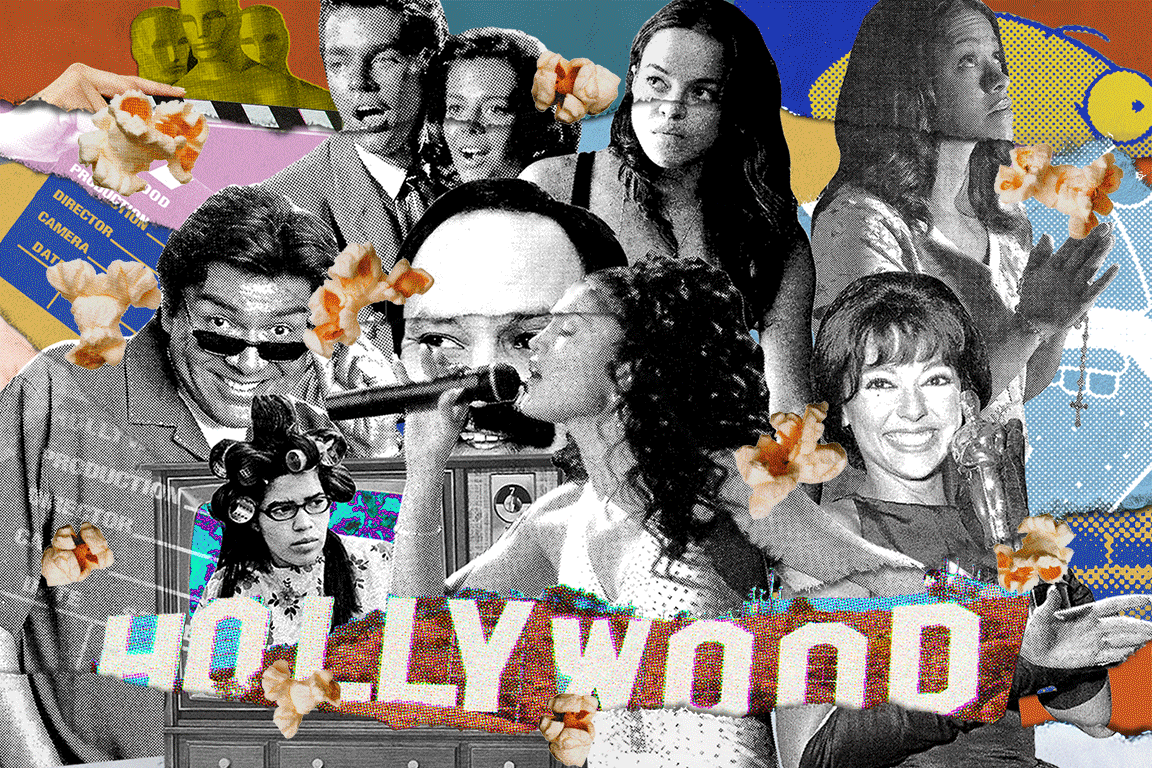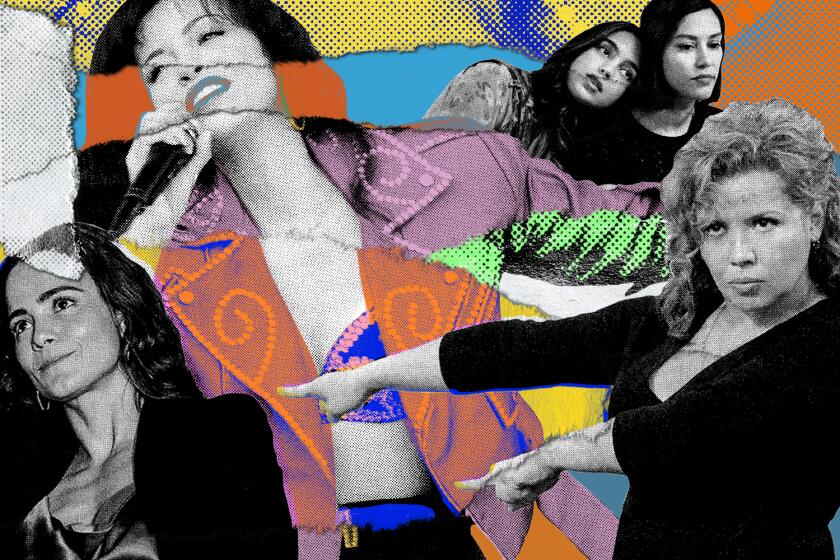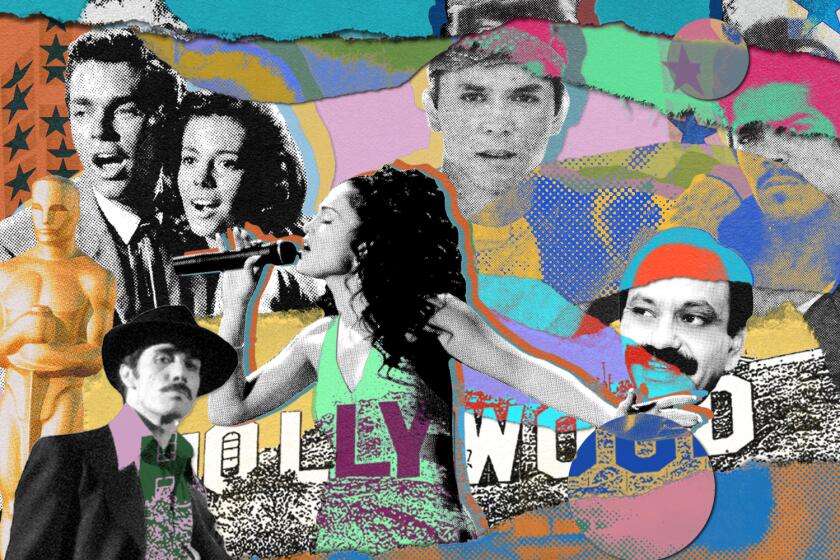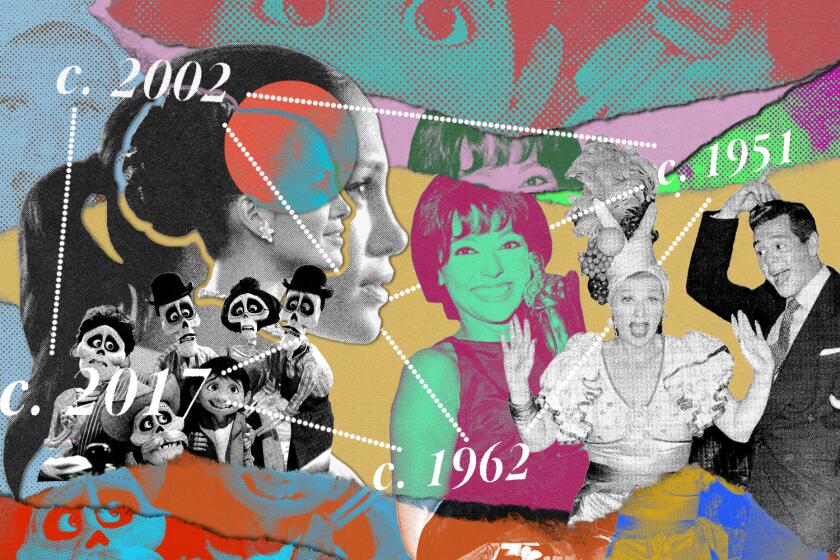SPECIAL REPORT
Hollywood's Latino Culture Gap
Times journalists examine the complicated history of Latinos in Hollywood and the actions being taken to increase their representation, which remains stubbornly low. FULL COVERAGE
Fifteen-year-old Taina Morales was a fictional character, but she represented the Latina everygirl of the 2000s: a passionate young woman with stadium-sized dreams, a boundless love for her family and a pair of hoop earrings for all occasions.
Created by Maria Perez-Brown (“Gullah Gullah Island,” “Model Latina”), the Nickelodeon teen sitcom “Taina” premiered Jan. 14, 2001. The show revolved around Puerto Rican diva-in-training Taina Morales and her fellow students at the Manhattan School of the Performing Arts, a fictional stand-in for the actual New York City fame factory, Fiorello H. LaGuardia High School of Music & Art and Performing Arts.
With a diverse cast of young actors — and featuring cameos by now-superstars Luis Fonsi, Shakira, Kelly Rowland and Solange Knowles — the show marked a turning point for kids’ television in the United States, where Latino characters, and more generally actors of color, were few and far between. “Taina” came on the air following a 1999 boycott of CBS, NBC, ABC and Fox protesting the “brownout” or lack of Latino TV shows and lead characters on the major networks and just months after Nickelodeon debuted the more male-centric, Mexican American sitcom, “The Brothers García” (for which a reboot was recently ordered by HBO Max). Despite the fact that ratings doubled in its second season, “Taina” was canceled in June 2002.
Since then, neither Nickelodeon, nor its parent company, ViacomCBS, has aired the show; it is only watchable on YouTube, where now-adult fans go to watch reruns and reminisce about some of the most memorable scenes. Fan favorites include the episode in which Taina sneakily buys a form-fitting hot-pink dress for her quinceañera, or her 15th birthday bash; when she botches a love letter to her crush, who could only speak Spanish; and her stint in the girl group Blue Mascara, played by real-life R&B trio 3LW.
Played by Puerto Rican actress, singer and LaGuardia graduate Christina Vidal — now Christina Vidal Mitchell — the role of Taina Morales was her first lead role. Vidal rings from the backyard of her home in Los Angeles, which she shares with husband Marcus Emanuel Mitchell and their two children. At the time, she thought of “Taina” as just one of many gigs, but 20 years later, Vidal Mitchell, 39, has come to understand her role as a critical milestone in a the history of Latinas in Hollywood.
When she was in her first movie at age 10 — opposite Michael J. Fox in 1993’s “Life With Mikey” — she says, “I used to wish that I could be the main character and not just the friend.” She later played supporting roles in the 1998 skate movie “Brink!” and the 2003 Lindsay Lohan comedy “Freaky Friday.” And last year, she starred in the extended-family sitcom “United We Fall” with Will Sasso and Jane Curtin; the series was canceled after one season.
But it’s “Taina” — which came out before “Hannah Montana,” “Victorious,” “Glee” and other shows centered on teen stardom and fame aspirations — that still generates social media love from fans.
“I had no idea that [‘Taina’] would be so impactful,” Vidal Mitchell tells The Times. “Not just for Latin girls and boys, but people of many colors and cultures.”
Your first role was playing a scrappy child star in “Life With Mikey.” How did you kick off your real-life acting career?
Some people would call it fate, but it was really my older sister Lisa [Vidal], who is a pretty well-known actress [“The Baker and the Beauty,” “Being Mary Jane”]. She started when she was 13 — sending out resumes, going to people’s offices all over the city and dropping off her picture. I was going to school in Whitestone, Queens, and heard about this audition, for a film with Michael J. Fox. They didn’t want an actor; they wanted a real street kid. Lisa coached me through my auditions, then flew with me to Canada, seven months pregnant with my nephew, and stayed with me through the first few weeks. I became the first Puerto Rican child to star in an American film.
Were you aware of what that meant at the time?
I didn’t. My first experience with Spanish press after “Life With Mikey” was embarrassing, because I did not speak Spanish fluently. I understand why Latinos [feel honored] when you speak their language; you’re keeping the culture alive. But I was very hurt that they didn’t acknowledge any other way that I was Puerto Rican. We need to do a better job of supporting each other, instead of looking for reasons to invalidate someone’s Latin-ness. But I did feel extremely supported by one famous Latino: Ruben Blades.
How did Ruben Blades make you feel supported?
He organized this huge luncheon for me. I remember being 11 years old and standing on a chair, in front of all these influential Latin people in the industry. They were all clapping for me. I thought, “I don’t know why I’m here, but I get free food and that’s awesome.”
Before “Taina,” you didn’t play explicitly Latina roles — you were in movies like “Brink!” and “Welcome to the Dollhouse.” How did you curate the roles you took as a teen?
At that time, there was no emphasis on playing one ethnicity. It was just about being an actor and playing a role. I mean, look at Al Pacino [in “Scarface”]. None of us cared about that awful accent, because it’s Al Pacino! What was important was … my mom wanted me to have a childhood, and was very selective about the roles I took. She let me work here and there, but during the summer, so I didn’t miss school. Spike Lee actually wanted me to be in “Crooklyn” — he even called my house personally — but my mom said no to Spike Lee!
As a Puerto Rican girl who attended New York’s famous performing arts school, LaGuardia, it’s as if you were destined to play “Taina.” How did you get the role?
I was in Germany with my pop group [Gemstone] when I got called to audition in L.A. Taina loved to sing and dance and act — and I love to do all three of those things. The character Taina had a birthday, and it was the same month as mine: November. And that birthday was chosen before I was chosen. It was eerie.
How did the show compare with your actual high school experience?
We both got in trouble with our teachers, but Taina had a much better work ethic. I was naturally talented, but I was lazy. And girls were not nice to me. One girl was like, a real Latin Queen [gang member] — they carried razors in their mouths all day. I guess she liked the guy that I was dating, so one day she said she’d cut my face after school. I was like, “Please don’t!” But one of my friends said something to her, this tough girl named Princess. And then we became friends.
In the show, there are tensions between Taina’s grandfather, who is from Puerto Rico, and the rest of the family, who grew up in New York. What was your relationship to Puerto Rican culture growing up?
In my family, being Puerto Rican was one of those things we didn’t question. Of course, being Nuyorican is different than being from the island. We spoke English, my mom spoke back to us in Spanish. And when she tried to get us to speak in Spanish, I allegedly said to her, “No, I sound like a jíbara!” It’s like saying you’re a hick. You don’t want to go around telling your mom how to be a mom, but I wish she didn’t let that slide.
We grew up in Queens, around a bunch of Italians and Jews. Almost everybody was white. I was darker than the other girls, and also had dark hair on my legs and a mustache. I always felt like an ugly little boy around the other girls. But Lisa, my oldest sister, she got bullied the worst. She used to get thrown off the school bus, and her books too. When my sister Tanya came around, she wore a leather jacket with a bunch of “I LOVE PUERTO RICO” buttons. She was like, “Say something to me and I will punch you in your face!” It wasn’t as bad once my brother and I got older.
Puerto Rican freestyle singer Lisa Lisa, who famously fronted the Cult Jam, played Taina’s mom on the show. Did you two connect over music?
She really looked out for me. She’d give me some some tips — like, “Girl, you don’t need to be washing your hair every day.” She said to spray it with some water, comb it, add a little product, and it’ll rejuvenate your curl without taking the moisture out of your hair. Game changer! She was also cool enough to let me sing one of her hits onstage at the New York premiere for “Taina.” But we got in trouble because we were only supposed to sing songs that Taina sings on the show.
Taina scored high ratings on Nickelodeon, but only got two seasons. There are many rumors as to why the show got canceled — some say it was budgeting, others say it was because it was a show about girls.
That’s ridiculous.
What was Nickelodeon’s explanation when they told you that the show wouldn’t be renewed for a third season?
They didn’t really say anything … just that they’d replace it with a show about Master P and his son. But I think it had something to do with me getting a record deal, and just not doing everything they wanted me to do. I wasn’t new to the business then — I was 20. I had a lawyer, I had people around me who knew my rights. This was a time when they had kids do a whole bunch of stuff without having any rights.
There have been accounts of shady behavior toward child actors at Nickelodeon — but you went in with an army.
And the general was my mother! I’ll give you a little tea. (Do the kids even say that anymore?) Well, I dated David Oliver Cohen, who plays Daniel, for a little bit. But then I was dating one of the choreographers at the time, who was much older than me. When my mom found out, ooh girl. ... She got him fired. She said, “You guys are not protecting my daughter if you’re allowing this to happen!” I’m a Christian, and I believe God gave me that mother for a reason.
So when you when you left the show, you decided to focus on music. What happened with that record deal?
I was signed to MCA. They wanted to make me a star. But a year later, the whole company got shut down and bought by some other company. The president of that company sat down with me and asked if I want to be the lead singer of the Pussycat Dolls. I was like, “So you want me to dress up in lingerie and sing these songs?” I wanted to be a solo artist, but they ultimately shelved my album.
You still found roles that integrated your singing ability into your acting ability. To this day, people on Twitter talk about Pink Slip, the band you fronted with Lindsay Lohan in “Freaky Friday!”
I guess “Freaky Friday,” “Brink!” and “Taina” all ended up being cult classics — I still don’t understand, but whatever brings people together, right?
In recent years, there’s been a heightened interest in Latino-centric television shows. The audience is there, but the networks often give these shows a season or two. The anomaly was “One Day at a Time,” which lasted three seasons on Netflix and one on Pop. What do you think needs to happen for Latinos to succeed in television?
Thanks to people like Eva Longoria and Gloria Calderón Kellett, [there] are conversations that are now happening in casting offices and networks: “We need diversity.” That’s really encouraging for me, because that means I’m getting way more opportunities. I can play characters I may have never [been cast for] because it would have just been assumed that the character was white.
But I want to keep the conversation at “Oh, here’s this really talented writer/director that we should look into …” instead of “Oh, here’s this Latin person we have to pacify for the Latin people so we don’t get them started now.”
We want to tell all the stories — it’s not about one over the other. I wish there was a way we could find that harmonious balance, but maybe the way to that is a little muddy and messy.














